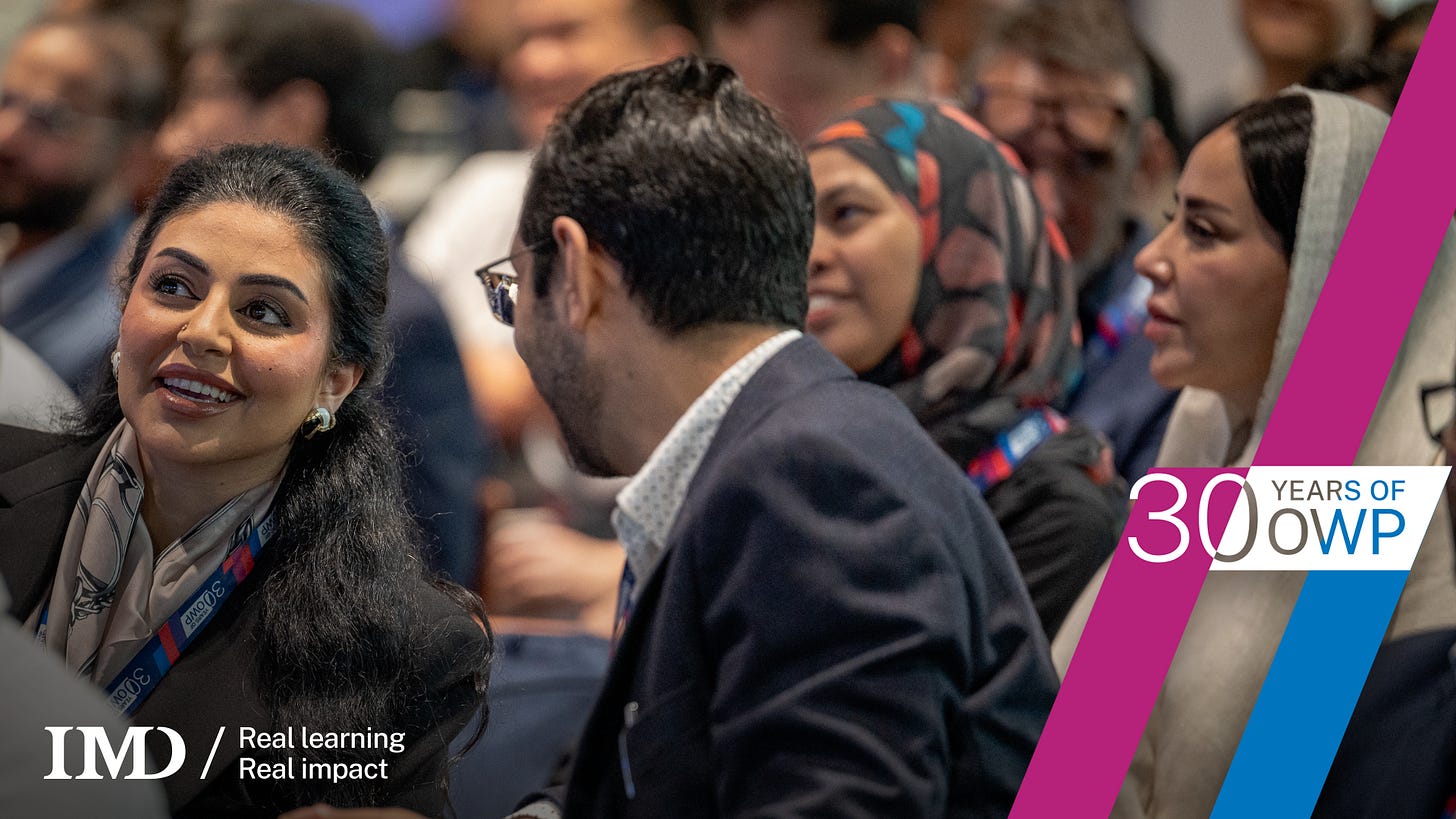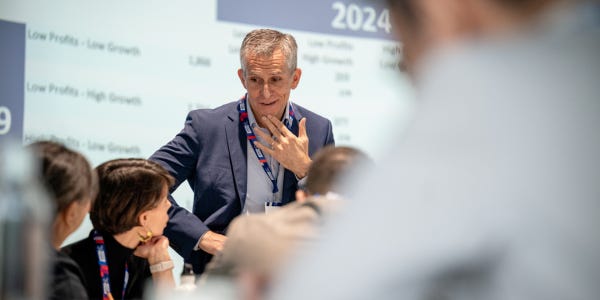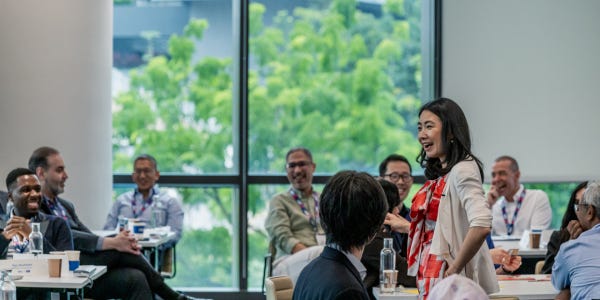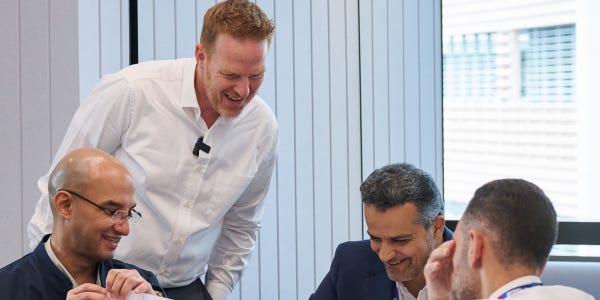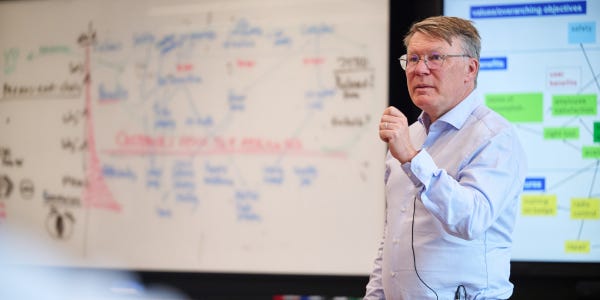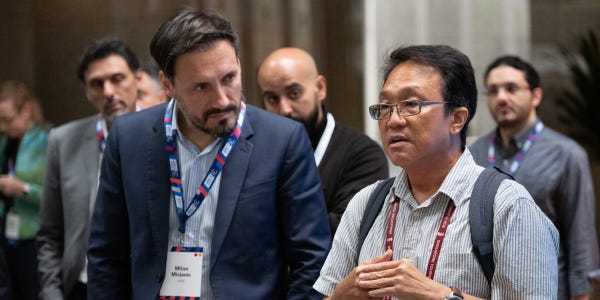Inside Orchestrating Winning Performance - Day One
In a world that feels increasingly fractured, 212 executives come together in Singapore this week for our signature Orchestrating Winning Performance program (OWP), representing 141 companies across 15 industries and 26 countries.
Under the theme “Thrive globally in a fragmented world,” OWP Singapore gives leaders room to step back, compare notes across markets, and pressure-test the choices that matter most right now: building future-ready organizations, leading through rapid digital change, and operating amid shifting geopolitical realities.
Throughout the week, we will open the door to the classrooms and keynotes, sharing practical insights from world-leading faculty and guests across leadership, strategy, AI and digital transformation, and geopolitics and society, focused on what leaders can actually put to work.
Watch highlights from the first day and read on for insights from today’s sessions.
What sets top companies apart?
What separates companies that sustain growth and profitability from those that do not? In his session How to sharpen, expand, and multiply, Professor Salvatore Cantale made a simple point: Being different is not the goal.
Drawing on research from over 7,000 listed companies worldwide, he shared that the top 5%, or what he calls the “resilient 390”, that managed to deliver both high growth and high profit exhibit common traits that link ambition to execution:
Connecting differentiation to customers’ willingness to pay
Building capabilities instead of perfecting products
Maintaining a greater share of sales and market presence in their strategic segments
Through a case study, Professor Cantale illustrated how even iconic companies must navigate the tension between innovation and focus. These companies treat strategy as an ongoing calibration of choices instead of a fixed plan, constantly balancing between exploitation and exploration.
As a practical way to think about this balance, he offered the S³ framework – sharpen the core by focusing on what drives value now, stretch into adjacent spaces that leverage existing strengths, and scout for weak signals and emerging shifts that could reshape the playing field.
“The winners at the top of the value chain don’t chase what’s different. They know how to monetize what makes them unique,” he said.
Finding joy in being wrong
Why is it so hard for smart people to change their minds? In her morning session The Joy of Being Wrong, Professor of Leadership and Organizational Behavior Zhike Lei explored why leaders struggle to rethink, and how embracing mistakes can become a source of learning and resilience.
Through interactive discussions and hands-on exercises, she guided participants to see how human judgement is shaped by shortcuts, emotions, and the team and business environments leaders navigate daily. A coin flip and math exercise revealed how anchoring and cognitive bias distort even simple reasoning. A puzzle exercise where teams reached different answers using the same information showed how assumptions, incomplete communication, and group narratives can drive confident misjudgment.
The bottom line? These outcomes mirror how organizations operate under pressure. “We are amazing, but we are also subject to being wrong,” she said. Alongside deploying an after-action review as a way to reflect and learn after the fact, leaders can go a step further by building pre-action and in-action reflection habits. This approach enables rethinking in real time, not just in hindsight.
Emotional and social factors make dealing with mistakes difficult. True leadership requires curiosity, humility, vulnerability, and the ability to show how others can challenge ideas without fear. And learning, as she reminded participants, is about embracing our mistakes, not avoiding them.
When winning isn’t everything
Amid fragmented markets and rising geopolitical tension, mastering competition within your market is not enough. During the afternoon’s How to win beyond the market session, David Bach, IMD President and Professor of Nestlé Professor of Strategy and Political Economy reminded participants that markets, while powerful, have limits. The question is, how can leaders shape what lies beyond it?
Through a high-energy simulation anchored on the logic of the Prisoners’ Dilemma, participants explored how short-term, economically rational decisions can lead to long-term value destruction.
The key lesson? Recognizing when competition destroys value is the first step to adapting your strategy. True leadership lies in balancing market and nonmarket forces, working with regulators, governments, and society to turn shared challenges into shared value.
“Today’s simulation was fun and surprisingly revealing. We started with one strategy, had to adapt mid-game, and ended with a very different perspective: value creation isn’t linear, and ‘winning’ isn’t always about the immediate score,” shared Nick Fiorito, Vice President of Sales at Prinova.
Valentina Chai, Chief Financial Officer of FIFGROUP (subsidiary of Jardine Matheson) explained, “In real life, decisions aren’t made in isolation. Success depends on aligning interests across a broader community. When the group collectively pursues an outcome that benefits everyone, the value created far exceeds what any one player could achieve alone.”
How customer-centric thinking drives revenue growth
In his session ‘How to grow revenues in tough markets’ Professor Stefan Michel, Dean of Faculty and Research at IMD, invited participants to rethink how real growth happens, not by adding more features, but by creating more value with customers.
“Every customer benefit either relieves pain or enables gain,” he explained. “If you can’t define which one you’re offering, it’s not a real benefit.”
Drawing on real case studies such as Hilti group, the session unpacked how leading firms evolve from selling products to delivering solutions, shifting from “what we make” to “what our customers need.” Through interactive exercises, executives mapped out how value is built and perceived: how reliability turns into trust, innovation into pride, and precision into performance.
Participants also explored how to translate these insights into strategy: identifying which customers are ready for solutions, aligning teams around customer outcomes, and designing pricing models that capture the value created.
Revenue growth, as Professor Michel reminded the group, isn’t about selling harder. It’s about thinking deeper, understanding the customer’s world better than anyone else, and charging for the value you create.
How does a city of just 734 km² plan for the future?
At the Urban Redevelopment Authority (URA), participants explored how Singapore blends vision, data, technology, and design to balance growth, livability, and sustainability. The visit revealed how the nation transforms land scarcity and climate challenges into opportunities for innovation.
Participant Abdulaziz M. Mallah reflected, “It’s incredible to see so many cultures and nations come together to learn from one another. Sessions like this remind us that growth starts with understanding how others think and live. This was by far one of the most interesting sessions I’ve ever attended.”
In the afternoon, participants visited the SMRT Corporation, which operates Singapore’s Mass Rapid Transit (MRT), light rail systems, and bus services. Here, the biggest takeaway was that profit is not the KPI; it’s safety and reliability. The emphasis of the organization is to provide something of value to others.
Niccolo Pisani, Professor of Strategy and International Business, who led the immersion, shared, “Something participants can take away from today is to look for adjacencies, and think of how to grow the business by looking at both core and non-core growth engines.”
Together, the URA and SMRT immersions showed how Singapore turns constraints into capability, anchoring in public value while building scalable engines for sustainable growth.
Stay tuned for highlights and insights from tomorrow!



